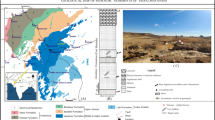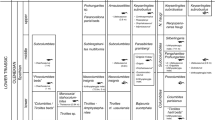Abstract
The Lower Cretaceous Pietraroia Plattenkalk (Benevento Province, southern Italy) has been known since the eighteenth century for its beautifully preserved fossil fishes. During Albian time (about 113 Myr ago1), deposition of fine marly limestone in a shallow lagoonal environment, affected by cyclic periods of low oxygen levels2, led to exceptional preservation of soft tissue in a juvenile theropod. The specimen, diagnosed here as Scipionyx samniticus gen. et sp. nov., is the first dinosaur ever to be found in Italy. The fossil has been mentioned previously in two brief notes3,4 and generally examined in a doctoral thesis5. Here we report the full preparation of the specimen which shows details of soft anatomy never seen previously in any dinosaur. The preservation is better than in other lagerstätten (conservative deposits)6 where theropod soft tissue has been reported, such as the Santana Formation of Brazil7 and the Yixian Formation of China8. Despite this, there is no evidence of feathers or any other integumentary remnants in the Italian specimen. Scipionyx represents a new maniraptoriform theropod. Its discovery is remarkable considering also the scarcity of juvenile theropod dinosaurs in the fossil record.
This is a preview of subscription content, access via your institution
Access options
Subscribe to this journal
Receive 51 print issues and online access
$199.00 per year
only $3.90 per issue
Buy this article
- Purchase on Springer Link
- Instant access to full article PDF
Prices may be subject to local taxes which are calculated during checkout





Similar content being viewed by others
References
Bravi, S. & De Castro, P. The Cretaceous fossil fishes level of Capo d'Orlando, near Castellammare di Stabia (NA): biostratigraphy and depositional environment. Mem. Sci. Geol. 47, 45–72 (1995).
Bravi, S. Contributo allo studio del giacimento ad ittioliti di Pietraroja (Benevento)(Thesis, Dip. Geol. Univ. Napoli “Federico II”, (1987)).
Leonardi, G. & Teruzzi, G. Prima segnalazione di uno scheletro fossile di dinosauro (Theropoda, Coelurosauria) in Italia (Cretacico di Pietraroia, Benevento). Paleocronache 1993, 7–14 (1993).
Leonardi, G. & Avanzini, M. Dinosauri in Italia. Le Scienze (Quaderni) 76, 69–81 (1994).
Signore, M. Il teropode del Plattenkalk della Civita di Pietraroia (Cretaceo inferiore, Bn)(Thesis, Dip. Paleont. Univ. Napoli “Federico II”, (1995)).
Seilacher, A. Begriff und Bedentung der Fossil-Lagerstätten. N. Jb. Geol. Paläont. Mh. Jahr. 1970, 34–39 (1970).
Kellner, A. Fossilized theropod soft tissue. Nature 379, 32 (1996).
Ji, Q. & Ji, S. On discovery of the earliest bird fossil in China and the origin of birds. Chinese Geol. 233, 30–33 (1996).
Ostrom, J. H. The osteology of Compsognathus longipes Wagner. Zitteliana 4, 73–118 (1978).
Benton, M. J. in The Dinosauria(eds Weishampel, D. B., Dodson, P. & Osmólska, H.) 11–30 (Univ. California, Berkeley, (1990).
Gauthier, J. in Mem. Calif. Acad. Sci.(ed. Padian, K.) 8, 1–55 (1986).
Holtz, T. R. J The phylogenetic position of the Tyrannosauridae: implications for theropod systematics. J. Paleontol. 68, 1100–1117 (1994).
Holtz, T. R. J Phylogenetic taxonomy of the Coelurosauria (Dinosauria: Theropoda). J. Paleontol. 70, 536–538 (1996).
Norell, M. A. et al. Atheropod dinosaur embryo and the affinities of the Flaming Cliffs dinosaur eggs. Science 266, 779–782 (1994).
Colbert, E. H. in Dinosaur Systematics(eds Carpenter, K. & Currie, P. J.) 81–90 (Cambridge Univ. Press, (1990)).
Molnar, R. E. in Dinosaur Systematics(eds Carpenter, K. & Currie, P. J.) 71–79 (Cambridge Univ. Press, (1990)).
Ostrom, J. H. Osteology of Deinonychus antirrhopus, an unusual theropod from the Lower Cretaceous of Montana. Bull. Peabody Mus. Nat. Hist. 30, 1–165 (1969).
Currie, P. J. & Zhao, X. Anew carnosaur (Dinosauria, Theropoda) from the Jurassic of Xinjiang, People's Republic of China. Can. J. Earth Sci. 30, 2037–2081 (1993).
Currie, P. J. et al. in Dinosaur Systematics(eds Carpenter, K. & Currie, P. J.) 107–125 (Cambridge Univ. Press, (1990)).
Currie, P. J. New information on the anatomy and relationships of Dromaeosaurus albertensis (Dinosauria: Theropoda). J. Vert. Paleontol. 15, 576–591 (1995).
Witmer, L. M. & Maxwell, W. D. The skull of Deinonychus (Dinosauria: Theropoda): new insights and implications. J. Vert. Paleontol. 16, 73A (1996).
Russell, D. A. & Dong, Z. Anearly complete skeleton of a new troodontid dinosaur from the Early Cretaceous of the Ordos Basin, Inner Mongolia, People's Republic of China. Can. J. Earth. Sci. 30, 2163–2173 (1993).
Barsbold, R. & Osmólska, H. in The Dinosauria(eds Weishampel, D. B., Dodson, P. & Osmólska, H.) 225–244 (Univ. California, Berkeley, (1990)).
Norman, D. B. in The Dinosauria(eds Weishampel, D. B., Dodson, P. & Osmólska, H.) 280–305 (Univ. California, Berkeley, (1990)).
Paul, G. S. Predatory Dinosaurs of the World 1–464 (Simon & Schuster, (1988)).
Gatesy, S. M. in Functional Morphology in Vertebrate Paleontology(ed. Thomason, J.) 219–234 (Cambridge Univ. Press, (1995)).
Guibé, J. Traité de Zoologie 14-II(ed. Grassé, P. P.) 521–548 (Masson, (1970)).
Wellnhofer, P. in The Beginning of Birds(eds Hecht, M. K., Ostrom, J. H., Viohl, G. & Wellnhofer, P.) 113–122 (Freunde des Jura-Museums, Eichstätt, (1985)).
Bryant, H. N. & Russell, A. P. The occurrence of clavicles within Dinosauria: implications for the homology of the avian furcula and the utility of negative evidence. J. Vert. Paleontol. 13, 171–184 (1993).
Norell, M. A. et al. AVelociraptor wishbone. Nature 389, 447 (1997).
Acknowledgements
We thank P. J. Currie and M. J. Benton for critical revision of the manuscript; C.Barbera, L. Chiappe, P. Makovicky, M. Norell, M. Novacek, E. Koppelhus, E.Nicholls, A. Kotsakis, D.Maxwell, R. Molnar, G. Pasini, E. Signore, G. Todesco, and L. Witmer; G.Leonardi for his encouragement; S. Rampinelli for the superb preparation of the specimen; G. Teruzzi, Dinosaur Project coordinator; and G. Tocco for allowing us to study the specimen. Photographs are by L.Vitola; drawings are by F. Fogliazza.
Author information
Authors and Affiliations
Corresponding author
Rights and permissions
About this article
Cite this article
Sasso, C., Signore, M. Exceptional soft-tissue preservation in a theropod dinosaur from Italy. Nature 392, 383–387 (1998). https://doi.org/10.1038/32884
Received:
Accepted:
Issue Date:
DOI: https://doi.org/10.1038/32884
This article is cited by
-
Heritage Outreach, Fossils, Dinosaurs and Sites: How Locals’ Perception Changes After 10 Years of Actions in Historic Urban Villages (Cuenca, Spain)
Geoheritage (2021)
-
A nearly complete respiratory, circulatory, and excretory system preserved in small Late Cretaceous octopods (Cephalopoda) from Lebanon
PalZ (2016)
-
A Cretaceous eutriconodont and integument evolution in early mammals
Nature (2015)
-
Can ovarian follicles fossilize?
Nature (2013)
-
A New Lower Cretaceous Vertebrate Bonebed Near Ariño (Teruel, Aragón, Spain); Found and Managed in a Joint Collaboration Between a Mining Company and a Palaeontological Park
Geoheritage (2012)
Comments
By submitting a comment you agree to abide by our Terms and Community Guidelines. If you find something abusive or that does not comply with our terms or guidelines please flag it as inappropriate.



